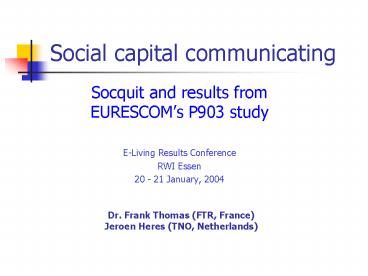Social capital communicating - PowerPoint PPT Presentation
1 / 18
Title:
Social capital communicating
Description:
FP6-IST, Lisbon Council, e-europe2005 actionplan, etc. ... (relations, work-, school-mates...) With whom the respondents was in contact (f2f, phone, mail... – PowerPoint PPT presentation
Number of Views:34
Avg rating:3.0/5.0
Title: Social capital communicating
1
Social capital communicating
- Socquit and results from EURESCOMs P903 study
- E-Living Results Conference
- RWI Essen
- 20 - 21 January, 2004
Dr. Frank Thomas (FTR, France) Jeroen Heres (TNO,
Netherlands)
2
ICTs to enhance Social Capital and Quality of
life (1)
- It is assumed that ICT will create societal
benefits - FP6-IST, Lisbon Council, e-europe2005 actionplan,
etc. - Social Capital often seen as a central mediating
factor for enhancing Quality of Life with ICT
3
ICTs to enhance Social Capital and Quality of
life (2)
- However, estimating impact of IST on Social
Capital and Quality of life is difficult - Effects are not straightforward
- Effects are dynamic (reciprocal)
Social Capital/ QoL
ICT use
4
SOCQUIT activities
- Analyzing state of the art knowledge
- Condensation into system dynamic model
- Validation of the model by data-analysis
- Making model applicable for policy and RTD by
creating decision support tool - Applying the model analyzing selected topics
- ? Initiating an expert network social
capital, quality of life and ICT
5
Objectives SOCQUIT
- Supporting RTD and policy (public and industrial)
by showing the estimated influence of (new) ISTs
on the development of social capital and quality
of life - Initiate expert networks and activities in this
subject area
6
Wanna be involved in SOCQUIT?
- Mailinglist (newsletter, latest results)
- Socquit-info_at_eurescom.de
- Website
- www.eurescom.de/socquit
- Partners
- TNO (coordinator)
- Telenor
- Chimera
- Eurescom
- FTR
7
Eurescom P-903
- Project 1999-2001
- Representative data about users and non-users of
mobile phone and Internet - focus on PRIVATE use
- 9 countries, advanced and starters
- more than 9000 respondents
- Data available for re-analysis
8
The general analytical framework
Values life styles
Attitudes to ICTs
Mob
.
phone
Mob
.
phone
Adoption
Domestication
and Use
Internet
Internet
Activities
Domestication
Adoption
social networks
and Use
geographical mobility
time use
9
Social network data in P903
kin
acquaintances (relations, work-, school-mates)
friends
abroad
national
local
With whom the respondents was in contact (f2f,
phone, mail)
10
Dimensions of social networks
- The size of the separate networks number of kin,
of friends, of acquaintances, of neighbours
contacted last month - The distance distribution of contacted kin,
friends, acquaintances
- Communications media used
- visits,
- fixed line telephone calls,
- mobile phone calls,
- emails,
- SMS,
- letters
- by distance groups, for kin, friends, and for
acquaintances - The social distance to kin, friends,
acquaintances, neighbours
11
What is meant by social capital? (1)
- PUTNAM
- features of social organization, such as
networks, norms, and trust, that facilitate
coordination and cooperation for mutual benefit - The stress is on collective action
12
What is meant by social capital? (2)
- WOOLCOCK and the World Bank Social Capital
Initiative - the norms and networks that facilitate
collective action... Any definition focus on its
sources rather than on consequences, .. This
approach eliminates an entity such as trust
from the definition .. i.e. social capital makes
most sense when it is understood as a relational
.. rather than a psychological .. or political ..
variable.
13
How is social capital measured
- Woolcocks proposal
- bonding capital relations among family members,
close friends and neighbours - bridging capital relations to more distant
friends, associates, colleagues, with similar
socio-demographic background - linking capital the capacity to leverage
resources, ideas, informations from formal
institutions beyond the community - a multi-dimensional approach integrates the three
forms and their dynamic combination over time - the institutional context, especially the role of
the state
14
Influences on social capital
- communication theory and the analysis of
sociability and ICT use at France Télécom RD - gender
- life cycle, the birth of the first child
- residential relocation
- besides
- income education
- place of residence
- usage characteristics length of use, general
intensity of use, technical expertise
15
The spatial boundedness of social capital
16
and the temporal boundedness of social capital
17
Bridging bonding capital and combined ICT use
18
Segmentation of ICT usage
- The results
- age
- household composition, gender
- education
- bridging capital
- no influence of length of residence
- limited influence of national contexts
- no influence of bonding capital
- The hypothesis
- social capital
- socio-demography
- gender age
- life cycle
- national context
- length of residence































